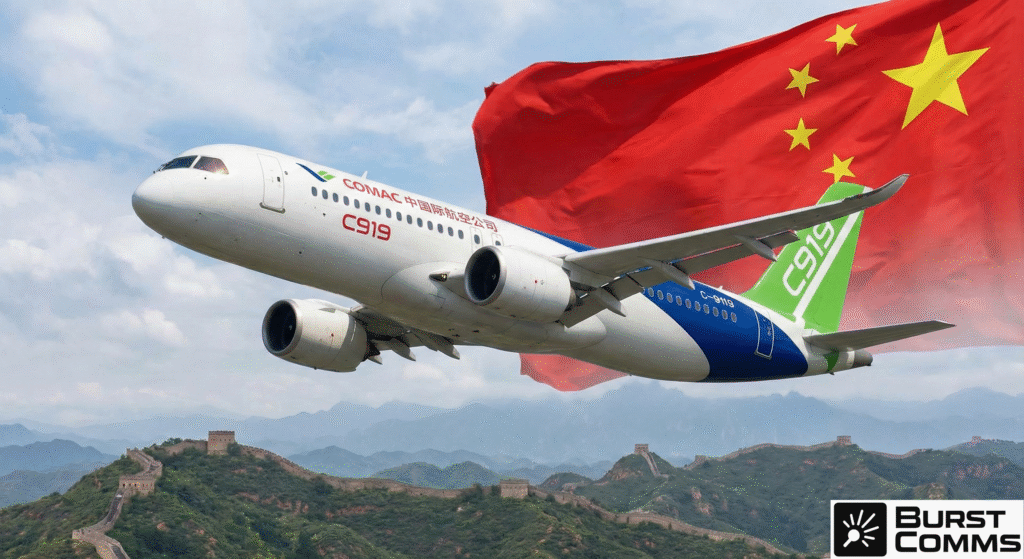
When China’s COMAC C919 finally entered commercial service, the headlines wrote themselves. A proud moment. A state-backed machine. An airliner that would end China’s dependence on Airbus and Boeing, at least on paper. But two years in, the numbers are quietly telling another story.
This isn’t a plane roaring into the global market. It’s a protected prototype with ambitions larger than its track record. The average C919 clocks just 5.2 flying hours per day. That’s three hours shy of what a mature narrowbody like the A320neo routinely handles. It’s not flying less because it’s inefficient. It’s flying less because it has to. The Chinese state cannot afford a “C919 MAX” moment. So the aircraft is eased into service with padded schedules and gentle routes, cocooned from the brutal realities of airline economics.
Technically, the C919 is a Western nervous system trapped inside a Chinese skeleton. It uses the LEAP-1C engine, a cousin of what powers Airbus and Boeing jets. Its avionics and flight control systems come from the likes of Honeywell and Collins. But COMAC doesn’t own this technology, it licenses it. It can’t debug it. And when something goes wrong, engineers often need help from vendors in the US, vendors now entangled in export control politics.
That fragility has already shown its hand. The aircraft’s innovative O-duct thrust reverser, meant to cut drag and improve efficiency, failed during deployment in early commercial service. The result? Cancelled flights and a ferry return to base. Not a catastrophic failure, but a reminder that innovation without integration is just risk.
Then there are the persistent software issues, false error messages, sensor mismatches, unexplained lockouts. The kinds of things legacy airframes like the A320 faced decades ago, but which were solved by having full control over the source code. COMAC doesn’t. It relies on foreign black boxes. So even minor technical hiccups can ground the aircraft for days. And with dispatch reliability hovering at 97–98%, that happens often enough to matter.
Supporters are quick to point out that Airbus struggled too. The A320’s early years were rocky, crashes, pilot confusion, bugs. But those were the growing pains of genuine innovation. The C919 isn’t trying to leap ahead. It’s trying to catch up. And even that’s proving complicated. The real challenge isn’t designing new tech, it’s bolting together parts never designed to coexist, then flying passengers in it.
But the story changes when you shift from cockpit to balance sheet. In China’s domestic market, the C919 doesn’t need to be better. It just needs to exist. State-owned banks offer subsidised lease deals that make the aircraft attractive regardless of its higher fuel burn or maintenance overhead. The maths may not work for Ryanair, but it works for China Eastern.
And yet, even that logic breaks down when geopolitics gets involved. In 2024, a suspension of US export licenses for key parts froze production. Aircraft were left parked, engines missing, deliveries stalled. COMAC had built a symbol of independence that couldn’t take off without an American signature. It’s now racing to develop the CJ-1000A engine to replace the LEAP, but analysts don’t expect it to reach parity for at least another decade. Until then, the aircraft remains dependent on foreign hardware that can be switched off like a tap.
That dependency ripples through the entire platform. The C919 is longer than the A320neo, but seats fewer passengers. It burns more fuel per seat. It relies on bulk-loaded cargo, rather than standard containers, which slows turnarounds. And without EASA or FAA certification, it can’t be resold globally or easily placed with a non-Chinese airline. It’s locked into the domestic market, a domestic market where the government decides what gets bought.
So what exactly is the C919? Not a market killer. Not yet a viable export product. It’s a symbol, a placeholder for the future. One that still breaks if you pull too hard. But that doesn’t make it irrelevant. Because what China is building isn’t just a jet. It’s a blueprint. A future where aviation, like semiconductors, like EVs, like AI, doesn’t rely on Boeing or Airbus.
For now, the plane flies. Slowly. Cautiously. Occasionally unreliably. But it flies. And that, in the eyes of the people backing it, is enough.